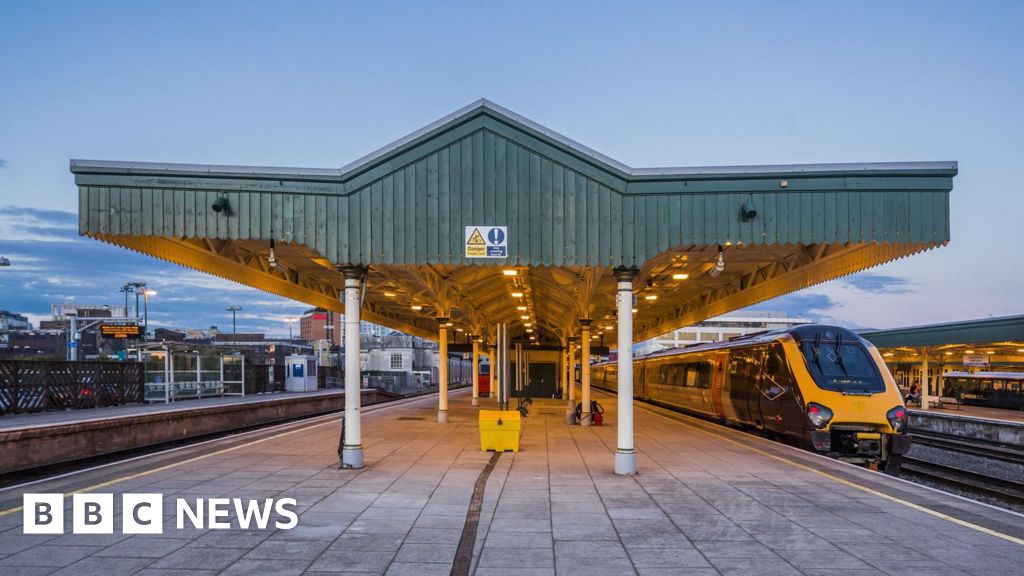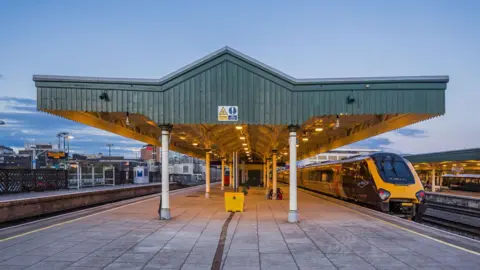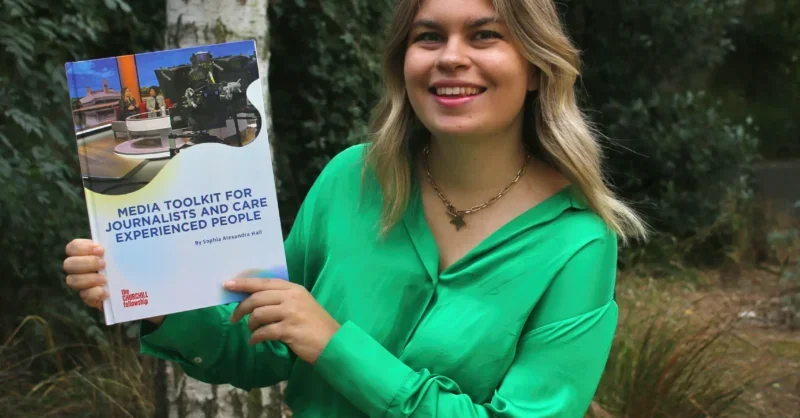Stevenage Museum was closed when I visited. But the church above it was open. St Andrew & St George, an airy Modernist concrete structure with a huge stained-glass window completed in 1966, the year England won the World Cup, was hosting a pantry to help locals out with a free cup of tea and a meal. The atmosphere was welcoming but restrained, a few people chatting, an older man eating a sandwich on his own, perched on a plywood pew.
Stevenage was once the future, a model for a new way of living. Its Modernism, mostly low-rise, functional and compact, looks almost quaint nowadays: an expression of a paternalistic era of state-sponsored building and council housing. In the 1950s, architects and urbanists came from all over the world to study the bold experiment that it embodied. Now it has become a kind of Modernist heritage, a version of a future that might have been.
Situated 27 miles north of London, Stevenage was the pioneering manifestation of the New Towns Act passed by parliament in 1946. It would be rapidly followed by Basildon and Bracknell, Corby and Crawley and, later, Runcorn, Ravenscraig, Cumbernauld and Telford — some successful, others a little less so. London had been devastated by bombing in the second world war, with more than a million dwellings damaged or destroyed, and the energetic new Labour government wasted no time in planning for a future dispersal of residents to beyond the war-torn, ragged and still industrial capital.


Now new towns are back as another new Labour government touts them as part of the solution to the UK’s housing crisis. The last government’s ambitious housebuilding targets were stymied by its own rural and suburban MPs, fearful of their constituents’ ire. Nimbyism has been a powerful force in politics. Almost everyone agrees on the need to build more houses — just not near where they live.
The new government’s legislative programme, set out in the King’s Speech this summer, suggested that communities would get a say on “how, not if” new homes are to be built. If the government is to confront the issue, new towns such as Stevenage must surely be back on the agenda. But are they, ultimately, a good thing?

Just before the election, the now deputy prime minister Angela Rayner revealed new visions of today’s towns of the future, renderings apparently created using AI that showed mistily nostalgic Edwardian-style red-brick mansion blocks, tree-lined streets and pavement cafés. Rayner, whose ministerial brief covers housing, suggested that only “attractive” homes would be built. Who, after all, objects to “attractive” housing? David Milner, director of the lobby group Create Streets (responsible for those images) writes: “We believe beautiful and sustainable design helps to boost housing delivery by winning over residents.”
The historicism of those machine hallucinations is a revealing echo of lingering British anxieties over style and modernity. The nation (or at least its developers) proved a little resistant to Modernism in the early 20th century, its public buildings veering between Neo-Georgian or Art Deco and its housing dominated by Artsy-Craftsy, half-timbered semis with the occasional stab at a more “continental” Modernism.
Stevenage represented a clean break. At its heart was the UK’s first Modernist town centre. Its design remains largely intact today; strolling through its streets, with their canopies, benches, green spaces and play areas, gives a little blast of postwar urban utopianism. The pedestrianised streets (also the nation’s first) might be a little shabbier than in mid-century photos; there are plenty of charity shops, slot-machine joints and a few big empty hulks (a defunct BHS and Poundland) but the centre is still lively.
One focal point is an abstract, sculptural clock tower, a ghost of that most municipal centrepiece of the Victorian city, here transformed into a Modernist monument to the place itself: a ceramic map of the new town on one side, on another a portrait of Lewis Silkin, the minister responsible for establishing new towns. When Silkin arrived in the small old town of Stevenage next to the site in 1946 he was confronted by protests about the 10,000 new council homes in the Hertfordshire countryside. “It’s no good you jeering,” he shouted over the crowd. “It’s going to be done.”
New developments provoke huge resistance and the UK’s planning system is immensely amenable to objections. It follows that the government’s plans are heavily skewed towards reform of the planning system. The quasi-religious sanctity of the greenbelt is sensibly being questioned, and areas identified as “grey belt” (which might consist of car parks, derelict buildings, transport sidings, agricultural structures or petrol stations) could be freed up. Analysis by estate agents Knight Frank suggests such sites might accommodate up to 200,000 homes, mostly in the south and particularly the areas surrounding London.
New towns, though, are something else. Although the government is consulting on potential locations, one of the most obvious sites is the Oxford-Cambridge corridor, a long-mooted plan for a “knowledge-intensive arc” that would have, more or less at its centre, the last and most successful of the UK’s new towns: Milton Keynes. This band of development could accommodate up to a million new homes and be planned around a revived Oxford-to-Cambridge rail line. One upside is employment and desirability — tech, biosciences and pharma are all well rooted here. The danger is proximity to London and the university cities — new towns could become dreary dormitory suburbs with little life of their own.
But whatever the risks, the need is there. According to a report by Schroders, the average house now costs nine times average earnings; in 1999 it was half that. If Britain is to house itself in the future, something will have to give.
Back at the church in Stevenage, I talked to rector Karen Mitchell. She introduced me to Jan and Mike Wilson who, she said, were the “real locals”.
“I’d been married for a year and I got a council house here after being on the waiting list for two weeks,” Mike told me. “When Stevenage was built, it was all council houses. Everything.”
Jan adds: “Now our granddaughter has been on the waiting list for years. And it’s hopeless, there’s always going to be someone more needy.” This is not just perception. There are currently 1.3mn households on local authority waiting lists.
Unlike the similarly cash-strapped postwar Labour government — which facilitated a huge programme of slum clearance, prefabrication and council housing (along with founding the NHS and the welfare state) — this government appears to suggest that the new housing will be delivered largely by the private sector.
Is this really the best route? There is little incentive for developers to flood the market with new homes and risk lowering prices, while huge public investment is needed in creating a new town. The postwar new towns were built by development corporations, government-established bodies that oversaw their planning and infrastructure. But this kind of large-scale planning has faded away as local authorities have been successively starved of cash in the post-austerity years. The 300 extra planners the government has promised will barely make a dent.
In 1946, as in 2024, a Labour government had to introduce legislation to create new towns. The question is whether we still have the same ambition and confidence. Stevenage was a determined statement of intent, of faith in modernity expressed through building. This was a town designed for the automobile age but with a pedestrianised centre and a station half an hour from London. What do we want towns to be now? Those twee pictures of Edwardian-style streets suggest a certain timidity.

Just as important as how they look is how they work and how they are financed. One economic tool used to great effect after the second world war — and is being considered again — is land value capture. The change in designation of land from agricultural to residential use can result (according to a recent report by the Centre for Progressive Policy) in an uplift of around 275 times the original value. Land speculation in the UK has had a crushing effect on new development, with landowners sitting on land until its value soars through change of use.
For the postwar wave of new towns, land was compulsorily purchased at its agricultural price — not including what is known as “hope value”, the expectation of uplift created by the proposals. The towns were then able to use that increase in the value of their holdings and reinvest in the community. Government assumed the risk and communities reaped the rewards. This method has faded away in the UK, yet the Dutch new town of Almere (often dismissed as dull but which I think is absolutely fascinating) managed to capture an astonishing 90 per cent of the uplift in value of its land for public infrastructure.


The vision of an enhanced community with the private house and garden at its centre also characterised earlier versions of the new town. Stevenage is sandwiched between Letchworth and Welwyn, two experiments in that much-studied English phenomenon, the garden city. The addition of the word “garden” has sometimes been used to appease objectors, as if sounding a little greener will assuage neighbours’ fears about the horrors of urbanity. The term is the invention of Ebenezer Howard, who wrote the short but enduringly influential Garden Cities of To-morrow (1898) — a book that emerged precisely from a fear of London as a traffic and smoke-choked hellhole.
Garden cities were to be limited in scale, surrounded by inviolable green belts; to be walkable, connected by public transport; and to contain all the elements required for a productive and civilised life: factories but also theatres and social clubs, market gardens, back gardens and even forests. They employed Community Land Trusts (non-profit corporations that held the land on behalf of the community while also acting as long-term stewards of public space) to keep control and maintain a stake in future success. They were gently ridiculed at the time as priggish places of self-consciously Arts and Crafts cottages, socialist sandals and skittles, towns with no pub. Letchworth’s main industry was a corset factory and it boasted the world’s first traffic roundabout (1904).
But the idea proved astonishingly influential. It spread to Australia (Canberra was planned as a garden city), Singapore, Zelenograd near Moscow (Lenin was rumoured to have visited Letchworth), the US (Augusta, Georgia, Reston, Virginia and the New Deal Greenbelt communities), to Christchurch in New Zealand and Jardim América in São Paulo.
If British garden cities are often mocked for their gentle suburbanity, you might also point to Milton Keynes, once derided as the zenith of late modern dullness but now a thriving city of more than 280,000 with an eccentric mix of architecture, landscape (influenced by prehistory and Stonehenge as much as by Los Angeles), “car-centricity” as well as walkability.
The confidence in the future that spawned Milton Keynes in the late 1960s has faded. As prime minister, Gordon Brown attempted to launch a new generation of new towns in 2007 and, to generate more enthusiasm, christened them “eco-towns”. David Cameron’s coalition government jumped on the garden city bandwagon and attempted to build one at Ebbsfleet in Kent, though it still it looks suspiciously like any other estate of executive homes. It remains, however, one of the most promising sites for a major new town with its connections to high-speed rail and the capital. Then chancellor George Osborne subsequently downgraded his ambitions to the painfully quaint notion of “garden villages”.
Building by decree is rarely straightforward. Take Palmanova, a garrison town established in 1593 by the Venetian Republic and intended as a model city. There are rumours that Leonardo da Vinci was involved and, even if he wasn’t, its form was certainly influenced by his designs, planned in a star shape for optimal artillery defence. It was a disaster. No one wanted to live there. The climate was wrong, the location dull, metropolitan life absent. In the end the authorities resorted to populating it with convicts who were gifted free homes in a desperate attempt to keep it alive. It is still a soporific rarity, an unattractive Renaissance town.

Cities thrive on unpredictability, culture and commerce but also a pinch of vice. That cocktail is difficult to plan for and utopian regulation often kills it. While sometimes lovely, ideal settlements founded by well-meaning industrialists (Titus Salt’s Saltaire, Cadbury’s Bournville or Czech shoemaker Bata’s Zlín) are tainted by worker-capture; the same idea as giving tech employees free snacks to keep them on campus.
2.8mnResidents currently housed in the UK’s postwar new towns
Then there is Poundbury, Britain’s own retro-royalist utopia — a future that looks like a feudal past, only with parking garages and a branch of Waitrose. Built on land outside Dorchester belonging to the Duchy of Cornwall, this new town/extension was built in a vernacular style with a touch of classical, a little Georgian and a sort-of-medieval picturesque street plan. It’s undeniably popular.
Meanwhile, our confidence in the future seems to have been hijacked by Big Tech billionaires with their missions to Mars and Moon-shots. For a while, “smart cities” seemed to be the future but these began to sound suspiciously like data-mining operations.
If we have lost that faith in the future that characterised Stevenage, and the ability to build the necessary large infrastructure (see the sorry HS2 high-speed rail saga), what is left is to expand existing successful cities. This is where the “grey-belt” reappears, the easing of the urban corset. But there are problems in even agreeing to what a city (or a city extension) of the future might look like.

The recent extraordinary reaction of the political right, in both the US and the UK, to the idea of “15-minute cities” — spinning the notion of a walkable, dense and well-distributed conurbation into a conspiracy theory about state control limiting citizens’ access to neighbourhoods in their cars — hints at these problems. Urbanists want compact quartiers, Paris-style, with local bakeries and surgeries; many homebuyers want double garages, driveways and big gardens. And the big developers that operate something close to a cartel in the UK market (their influence is unique in Europe and the results have been dire) like these better too — easier to build, and no problems with pesky infrastructure.
Perhaps to counter the pervasive presence and influence of the housebuilders, there might also be space to accommodate self-builders and eccentrics, places designated for experiments in new ways of communal living, new forms of ownership, new kinds of architecture. The rhetoric at the moment leans towards design codes and control, which is fine. But if the government is revising planning law, it could revisit rules facilitating residents to build their own more individual homes, suited to their particular needs. Almere allowed residents to design their homes any way they wish, with no aesthetic controls. The results are occasionally bizarre but they also accommodate eccentricity and individuality. Are these not a critical element of the English sense of identity?
The postwar British new towns now house 2.8mn people and were, in retrospect, an audacious and incredible success. If there is a lesson to be drawn from them, it might be that government needs to take a central role. This is not something that can be left solely to a private sector that demands short-term profit. There is also an opportunity to revisit the commodification of housing that has led to the crisis. There are other forms of tenure beyond home ownership.
Cities take time to build. If there are a few mistakes along the way, they can be rectified in the future. And we can take heart in one thing: this has been done before.
Edwin Heathcote is the FT’s architecture critic
Find out about our latest stories first — follow FT Weekend on Instagram and X, and subscribe to our podcast Life & Art wherever you listen





















































































































































You must be logged in to post a comment Login